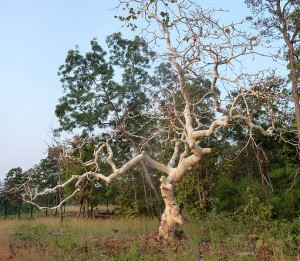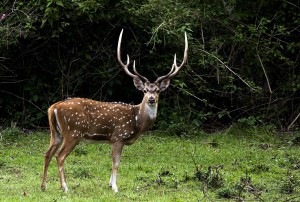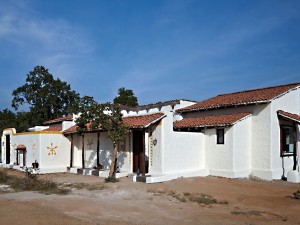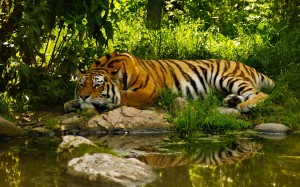Yvette recently returned from a trip to India where she spent part of her colorful journey in the four national parks of India’s “Central Province” of Madhya Pradesh. One of the first questions most of her friends and clients have asked, is how the wildlife experience in India compares to that of an African safari.
Let’s start with the Flora…
Unlike Africa’s savannah plains or bush, the National Parks and Reserves were all in relatively forested areas. Panna is for the most part a deciduous Teak forest which dramatically changes from lush green during the monsoon to dry grey in summer. Bandhavgarh and Kanha are mostly a mix of semi-deciduous Sal trees & Bamboo while Pench (the inspiration for Mowgli’s environment in Jungle book), is an abundant mix of Teak and Bamboo. Throughout all of them, there are maidans, open grassy meadows that have sprung up where villages had been evacuated to make way for the wildlife, and other tree species such as Asna (aptly nick-named “crocodile bark tree”) and the intriguing white Kulu or “ghost trees”.
dry grey in summer. Bandhavgarh and Kanha are mostly a mix of semi-deciduous Sal trees & Bamboo while Pench (the inspiration for Mowgli’s environment in Jungle book), is an abundant mix of Teak and Bamboo. Throughout all of them, there are maidans, open grassy meadows that have sprung up where villages had been evacuated to make way for the wildlife, and other tree species such as Asna (aptly nick-named “crocodile bark tree”) and the intriguing white Kulu or “ghost trees”.
And Fauna…
It would almost be meaningless to compare the two destinations in terms of the variety of species, and their numbers, especially big cats. Where it would not be uncommon to encounter several prides of lion, and one or two cheetah families during a visit to Kenya’s Masai Mara, a park like Bandhavgarh in India, can rightly boast one of the densest populations of Bengal tigers on earth, yet fewer than 20 of them live the 65 square mile section of the park open to the public. (A further 200 square miles remain a restricted sanctuary to ± 30 more). While the reserves are small, by comparison to over 9,000 square miles of the Okavango Delta or Serengeti, tigers remain elusive and it is not at all unusual to go out on game drives without seeing a single one. What is interesting, however is to compare the species one does find, with some of those in Africa. As ubiquitous as the impala in Africa, is the gorgeous spotted deer, or chital in India. But rather than the gracious horns of the antelopes, the males grow the most impressive sets of antlers which they shed every year.  As entertaining as the vervet monkeys, are the Gray langurs or Hanuman langurs, with their tails so long it can be tough to fit the whole body in a camera’s viewfinder when they’re perched on the branch of a tree.
As entertaining as the vervet monkeys, are the Gray langurs or Hanuman langurs, with their tails so long it can be tough to fit the whole body in a camera’s viewfinder when they’re perched on the branch of a tree.
The Accommodations: As in Africa, it is impossible to tell the good from the bad and the ugly by roaming about on the internet. The options are at the same time vast,  yet limited though. Vast in the sense that – particularly around the more celebrated parks like Bandhavgarh – there are hundreds of lodges that beckon to back-packers, self-drivers and foreign tourists indiscriminately. Authentic and intimate owner operated properties, or the more sophisticated high-end lodges are few, and (quite literally) far between. Of those, some are fashioned after the African safari lodges and tented camps, others pay homage to the local village architecture of clay and thatch, and only some succeed in that rare balance between being authentic to the immediate locale, and delivering the essential service and “creature comforts’ that the 21st century traveler anticipates across the globe. So it is probably best to trust a professional who not only visits these camps and lodges in person, but also understands the importance of the right ambiance overall, the typical expectations and the features and facilities that matter to you specifically.
yet limited though. Vast in the sense that – particularly around the more celebrated parks like Bandhavgarh – there are hundreds of lodges that beckon to back-packers, self-drivers and foreign tourists indiscriminately. Authentic and intimate owner operated properties, or the more sophisticated high-end lodges are few, and (quite literally) far between. Of those, some are fashioned after the African safari lodges and tented camps, others pay homage to the local village architecture of clay and thatch, and only some succeed in that rare balance between being authentic to the immediate locale, and delivering the essential service and “creature comforts’ that the 21st century traveler anticipates across the globe. So it is probably best to trust a professional who not only visits these camps and lodges in person, but also understands the importance of the right ambiance overall, the typical expectations and the features and facilities that matter to you specifically.
Guiding & the Safari Experience
 At African Portfolio we know that a great safari is as much a thrill of discovery as an enriching learning experience and greatly dependent on good quality guiding. All over India, excellent naturalists (as they usually prefer to be called) can be found, but should not be presumed. Under excruciating pressure from tourists, many if not most, will focus entirely on finding a tiger to the point where the guest feels much like a hunter without the gun. We all know how much cats like to sleep, so it is not uncommon to spend an hour or two or three (!) in one place waiting for a movement – any movement. A 10-second stroll across a cleared path, and the sound of camera shutters from two dozen open vehicles can be like that of a celebrity appearance on a red carpet. It can feel much more like the triumph of the catch while fishing, than the immersive and informative game drive that we’re accustomed to in Africa. Of course there are ways to avoid these crowds and enhance the experience tenfold with the right guides in the right places, but if you want guarantees, talk to a travel specialist.
At African Portfolio we know that a great safari is as much a thrill of discovery as an enriching learning experience and greatly dependent on good quality guiding. All over India, excellent naturalists (as they usually prefer to be called) can be found, but should not be presumed. Under excruciating pressure from tourists, many if not most, will focus entirely on finding a tiger to the point where the guest feels much like a hunter without the gun. We all know how much cats like to sleep, so it is not uncommon to spend an hour or two or three (!) in one place waiting for a movement – any movement. A 10-second stroll across a cleared path, and the sound of camera shutters from two dozen open vehicles can be like that of a celebrity appearance on a red carpet. It can feel much more like the triumph of the catch while fishing, than the immersive and informative game drive that we’re accustomed to in Africa. Of course there are ways to avoid these crowds and enhance the experience tenfold with the right guides in the right places, but if you want guarantees, talk to a travel specialist.
Lasting Impressions…
Of India’s almost 3,000,000 square miles, roughly 5% is currently protected for wildlife so there is clearly way more to this country than the renowned “Tiger Safari”. It is unlikely that a first-time traveler would want to forgo much of the so-called “golden triangle” of Delhi, Agra and Jaipur, or at least a glimpse of the majestic Taj Mahal. So consider the game viewing opportunities a fortuitous “bonus”, but remember that it remains but one ingredient in the rich and flavorful amalgam of temples and tigers, palaces and peacocks, fables, forts and much, much more, that will constitute your outlandish adventure in “Incredible India” … indeed.